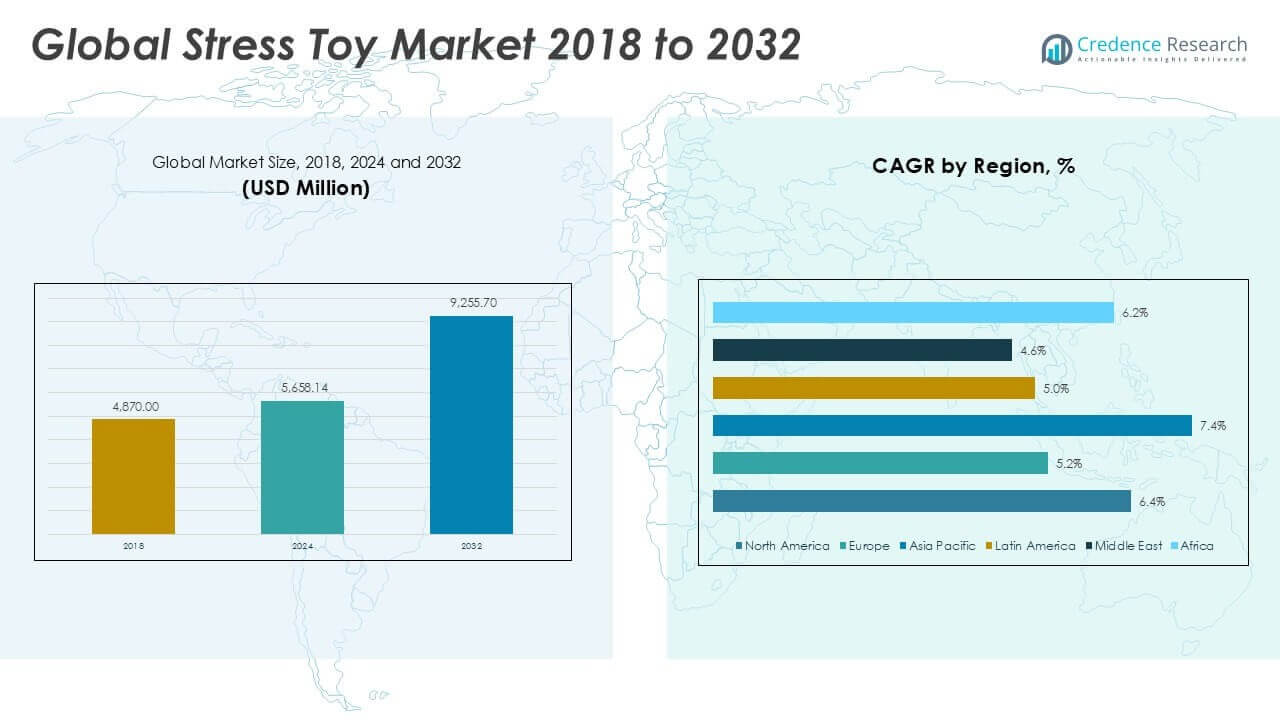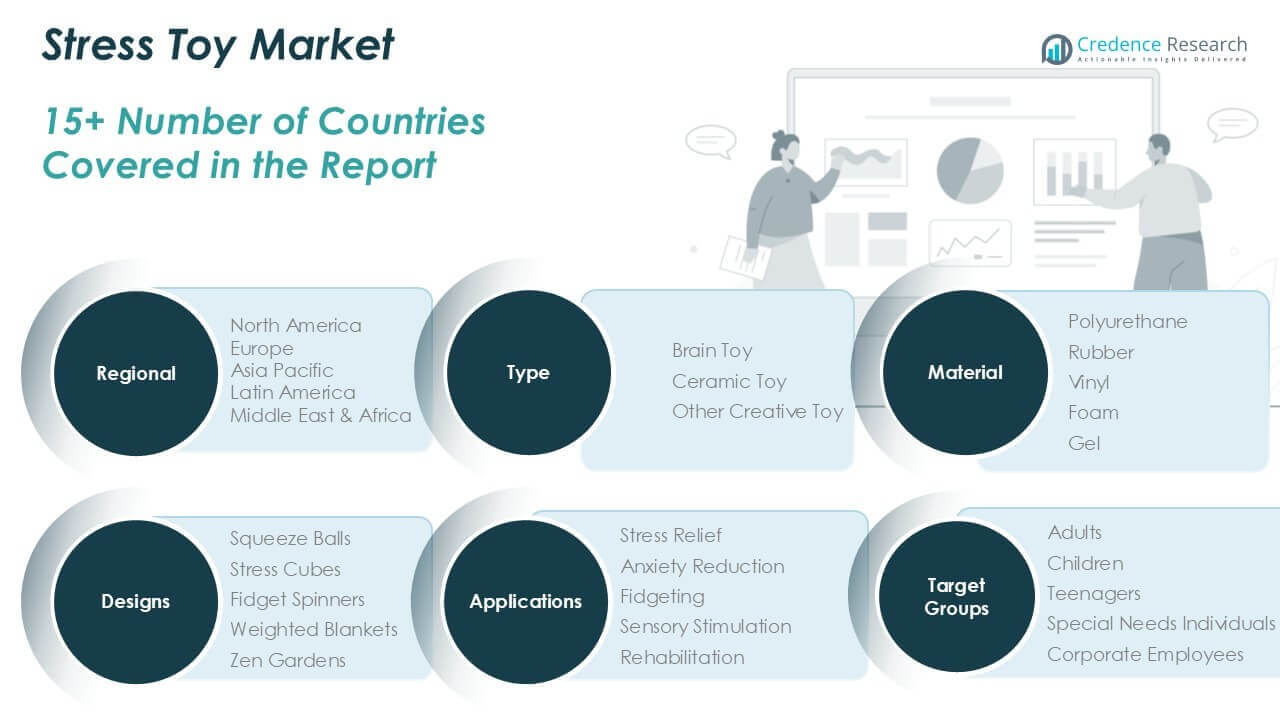CHAPTER NO. 1 : GENESIS OF THE MARKET
1.1 Market Prelude – Introduction & Scope
1.2 The Big Picture – Objectives & Vision
1.3 Strategic Edge – Unique Value Proposition
1.4 Stakeholder Compass – Key Beneficiaries
CHAPTER NO. 2 : EXECUTIVE LENS
2.1 Pulse of the Industry – Market Snapshot
2.2 Growth Arc – Revenue Projections (USD Million)
2.3. Premium Insights – Based on Primary Interviews
CHAPTER NO. 3 : STRESS TOY MARKET FORCES & INDUSTRY PULSE
3.1 Foundations of Change – Market Overview
3.2 Catalysts of Expansion – Key Market Drivers
3.2.1 Momentum Boosters – Growth Triggers
3.2.2 Innovation Fuel – Disruptive Technologies
3.3 Headwinds & Crosswinds – Market Restraints
3.3.1 Regulatory Tides – Compliance Challenges
3.3.2 Economic Frictions – Inflationary Pressures
3.4 Untapped Horizons – Growth Potential & Opportunities
3.5 Strategic Navigation – Industry Frameworks
3.5.1 Market Equilibrium – Porter’s Five Forces
3.5.2 Ecosystem Dynamics – Value Chain Analysis
3.5.3 Macro Forces – PESTEL Breakdown
3.6 Price Trend Analysis
3.6.1 Regional Price Trend
3.6.2 Price Trend by product
CHAPTER NO. 4 : KEY INVESTMENT EPICENTER
4.1 Regional Goldmines – High-Growth Geographies
4.2 Product Frontiers – Lucrative Product Categories
4.3 Application Sweet Spots – Emerging Demand Segments
CHAPTER NO. 5: REVENUE TRAJECTORY & WEALTH MAPPING
5.1 Momentum Metrics – Forecast & Growth Curves
5.2 Regional Revenue Footprint – Market Share Insights
5.3 Segmental Wealth Flow – Type & Application Revenue
CHAPTER NO. 6 : TRADE & COMMERCE ANALYSIS
6.1.Import Analysis by Region
6.1.1. Global Stress Toy Market Import Revenue By Region
6.2.Export Analysis by Region
6.2.1. Global Stress Toy Market Export Revenue By Region
CHAPTER NO. 7 : COMPETITION ANALYSIS
7.1.Company Market Share Analysis
7.1.1. Global Stress Toy Market: Company Market Share
7.2. Global Stress Toy Market Company Revenue Market Share
7.3.Strategic Developments
7.3.1.Acquisitions & Mergers
7.3.2. New Product Launch
7.3.3. Regional Expansion
7.4. Competitive Dashboard
7.5. Company Assessment Metrics, 2024
CHAPTER NO. 8 : STRESS TOY MARKET – BY TYPE SEGMENT ANALYSIS
8.1.Stress Toy Market Overview by Type Segment
8.1.1. Stress Toy Market Revenue Share By Type
8.2. Brain Toy
8.3. Ceramic Toy
8.4.Other Creative Toy
CHAPTER NO. 9 : STRESS TOY MARKET – BY APPLICATION SEGMENT ANALYSIS
9.1.Stress Toy Market Overview by Application Segment
9.1.1. Stress Toy Market Revenue Share By Application
9.2. Stress Relief
9.3. Anxiety Reduction
9.4. Fidgeting
9.5. Sensory Stimulation
9.6. Rehabilitation
CHAPTER NO. 10 : STRESS TOY MARKET – BY TARGET GROUP SEGMENT ANALYSIS
10.1.Stress Toy Market Overview by Target Group Segment
10.1.1. Stress Toy Market Revenue Share By Target Group
10.2.Adults
10.3.Children
10.4. Teenagers
10.5. Special Needs Individuals
10.6.Corporate Employees
CHAPTER NO. 11 : STRESS TOY MARKET – BY MATERIAL SEGMENT ANALYSIS
11.1.Stress Toy Market Overview by Material Segment
11.1.1. Stress Toy Market Revenue Share By Material
11.2. Polyurethane
11.3. Rubber
11.4. Vinyl
11.5. Foam
11.6. Gel
CHAPTER NO. 12 : STRESS TOY MARKET – BY DESIGNS SEGMENT ANALYSIS
12.1.Stress Toy Market Overview by Designs Segment
12.1.1. Stress Toy Market Revenue Share By Designs
12.2. Squeeze Balls
12.3.Stress Cubes
12.4. Fidget Spinners
12.5. Weighted Blankets
12.6. Zen Gardens
CHAPTER NO. 13 : STRESS TOY MARKET – REGIONAL ANALYSIS
13.1.Stress Toy Market Overview by Region Segment
13.1.1. Global Stress Toy Market Revenue Share By Region
13.1.2.Regions
13.1.3.Global Stress Toy Market Revenue By Region
13.1.4.Type
13.1.5.Global Stress Toy Market Revenue By Type
13.1.6.Application
13.1.7. Global Stress Toy Market Revenue By Application
13.1.8.Target Group
13.1.9. Global Stress Toy Market Revenue By Target Group
13.1.10. Material
13.1.12. Global Stress Toy Market Revenue By Material
13.1.13. Designs
13.1.14. Global Stress Toy Market Revenue By Designs
CHAPTER NO. 14 : NORTH AMERICA STRESS TOY MARKET – COUNTRY ANALYSIS
14.1.North America Stress Toy Market Overview by Country Segment
14.1.1.North America Stress Toy Market Revenue Share By Region
14.2.North America
14.2.1.North America Stress Toy Market Revenue By Country
14.2.2.Type
14.2.3.North America Stress Toy Market Revenue By Type
14.2.4.Application
14.2.5.North America Stress Toy Market Revenue By Application
14.2.6.Target Group
14.2.7.North America Stress Toy Market Revenue By Target Group
14.2.8.Material Type
14.2.9.North America Stress Toy Market Revenue By Material
14.2.10.Designs
14.2.11.North America Stress Toy Market Revenue By Designs
14.3.U.S.
14.4.Canada
14.5.Mexico
CHAPTER NO. 15 : EUROPE STRESS TOY MARKET – COUNTRY ANALYSIS
15.1. Europe Stress Toy Market Overview by Country Segment
15.1.1. Europe Stress Toy Market Revenue Share By Region
15.2.Europe
15.2.1.Europe Stress Toy Market Revenue By Country
15.2.2.Type
15.2.3.Europe Stress Toy Market Revenue By Type
15.2.4.Application
15.2.5. Europe Stress Toy Market Revenue By Application
15.2.6.Target Group
15.2.7. Europe Stress Toy Market Revenue By Target Group
15.2.8.Material Type
15.2.9. Europe Stress Toy Market Revenue By Material
15.2.10.Designs
15.2.11. Europe Stress Toy Market Revenue By Designs
15.3.UK
15.4.France
15.5.Germany
15.6.Italy
15.7.Spain
15.8.Russia
15.9. Rest of Europe
CHAPTER NO. 16 : ASIA PACIFIC STRESS TOY MARKET – COUNTRY ANALYSIS
16.1.Asia Pacific Stress Toy Market Overview by Country Segment
16.1.1.Asia Pacific Stress Toy Market Revenue Share By Region
16.2.Asia Pacific
16.2.1. Asia Pacific Stress Toy Market Revenue By Country
16.2.2.Type
16.2.3.Asia Pacific Stress Toy Market Revenue By Type
16.2.4.Application
16.2.5.Asia Pacific Stress Toy Market Revenue By Application
16.2.6.Target Group
16.2.7.Asia Pacific Stress Toy Market Revenue By Target Group
16.2.8.Material Type
16.2.9.Asia Pacific Stress Toy Market Revenue By Material
16.2.10.Designs
16.2.11.Asia Pacific Stress Toy Market Revenue By Designs
16.3.China
16.4.Japan
16.5.South Korea
16.6.India
16.7.Australia
16.8.Southeast Asia
16.9. Rest of Asia Pacific
CHAPTER NO. 17 : LATIN AMERICA STRESS TOY MARKET – COUNTRY ANALYSIS
17.1.Latin America Stress Toy Market Overview by Country Segment
17.1.1.Latin America Stress Toy Market Revenue Share By Region
17.2. Latin America
17.2.1. Latin America Stress Toy Market Revenue By Country
17.2.2.Type
17.2.3. Latin America Stress Toy Market Revenue By Type
17.2.4.Application
17.2.5.Latin America Stress Toy Market Revenue By Application
17.2.6.Target Group
17.2.7.Latin America Stress Toy Market Revenue By Target Group
17.2.8.Material Type
17.2.9.Latin America Stress Toy Market Revenue By Material
17.2.10.Designs
17.2.11.Latin America Stress Toy Market Revenue By Designs
17.3.Brazil
17.4.Argentina
17.5.Rest of Latin America
CHAPTER NO. 18 : MIDDLE EAST STRESS TOY MARKET – COUNTRY ANALYSIS
18.1.Middle East Stress Toy Market Overview by Country Segment
18.1.1.Middle East Stress Toy Market Revenue Share By Region
18.2.Middle East
18.2.1. Middle East Stress Toy Market Revenue By Country
18.2.2.Type
18.2.3.Middle East Stress Toy Market Revenue By Type
18.2.4.Application
18.2.5.Middle East Stress Toy Market Revenue By Application
18.2.6. Target Group
18.2.7.Middle East Stress Toy Market Revenue By Target Group
18.2.8. Material Type
18.2.9.Middle East Stress Toy Market Revenue By Material
18.2.10. Designs
18.2.11.Middle East Stress Toy Market Revenue By Designs
18.3.GCC Countries
18.4. Israel
18.5. Turkey
18.6.Rest of Middle East
CHAPTER NO. 19 : AFRICA STRESS TOY MARKET – COUNTRY ANALYSIS
19.1. Africa Stress Toy Market Overview by Country Segment
19.1.1.Africa Stress Toy Market Revenue Share By Region
19.2. Africa
19.2.1.Africa Stress Toy Market Revenue By Country
19.2.2.Type
19.2.3.Africa Stress Toy Market Revenue By Type
19.2.4.Application
19.2.5. Africa Stress Toy Market Revenue By Application
19.2.6.Target Group
19.2.7. Africa Stress Toy Market Revenue By Target Group
19.2.8.Material Type
19.2.9. Africa Stress Toy Market Revenue By Material
19.2.10.Designs
19.2.11. Africa Stress Toy Market Revenue By Designs
19.3. South Africa
19.4.Egypt
19.5.Rest of Africa
CHAPTER NO. 20 : COMPANY PROFILES
20.1. Adventure Force
20.1.1.Company Overview
20.1.2.Product Portfolio
20.1.3.Financial Overview
20.1.4.Recent Developments
20.1.5.Growth Strategy
20.1.6.SWOT Analysis
20.2.Alex Brands
20.3.Basic Fun, Inc.
20.4.Buzz Bee Toys
20.5.Hasbro, Inc.
20.6.JT SplatMaster
20.7.Les Jeux MGA
20.8. Marshmallow Fun Company
20.9. Mattel, Inc.
20.10. Prime Time Toys Ltd.
20.11.Skullduggery, Inc.
20.12. Umarex USA
20.13.ZING
20.14.ZURU, Inc.





